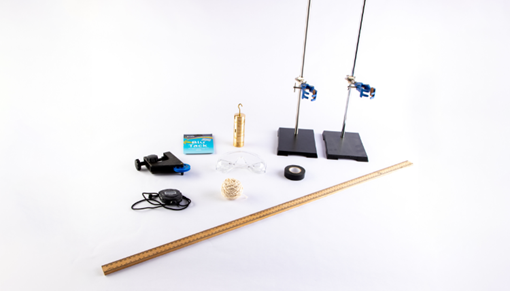
Acceleration
Demonstrate how force, mass and acceleration are all related.
In this required practical, students investigate the effects of varying the mass and force on an accelerating object. The activities include measuring the time taken for a trolley of constant mass and a trolley of varied mass to travel over a fixed distance. Students then calculate the acceleration of the vehicle in both instances. The students must then reflect on whether their results are concurrent with Newton’s Second Law along with accuracy and any possible sources of error.

Equipment (per pair of participants)
• Safety glasses
• Toy car
• Metre ruler
• Bench pulley
• String
• Set of newton masses
• 2 x retort stand and clamp
• Blue tac
• Stopwatch
• Tape
• Spare 100g masses
• Square of cardboard with a hole in
• A selection of insulating materials
• Scissors
• Elastic bands
Method
Activity 1: Recording the effects of force on acceleration at a constant mass.
- Students should collect the necessary equipment. They then measure and mark out set distances along the bench that they are working on, using a metre ruler and some tape as the markers.
- The bench pulley is secured to the end of the desk that the students have marked.
- A piece of string is tied to one end of the vehicle and is passed over the pulley. The other end of the string is tied into a loop ready for attaching a Newton Mass hanger.
- Students need to ensure that the string is horizontal and in line with the vehicle, they should then pull the vehicle backwards along the bench and place this on the starting line on the desk.
- The stopwatch needs to be put into lap mode and one student should hold the vehicle in place on the starting line. The other participant should fill the Newton mass hanger with slotted masses and attach this to the loop on the end of the string which is over the pulley.
- The participant then releases the vehicle and at the same time as starting the stopwatch. They should press the lap button on the stopwatch each time the vehicle passes one of their sellotape markers. The stopwatch is stopped when the vehicle reaches the end of the bench.
- The lap results for each marker are then recorded in a suitable table.
- Steps 4-7 above should then be repeated removing one of the slotted masses each time, placing each of the removed masses on top of the vehicle after they have been removed from the hanger
Activity 2: Recording the effects of mass on acceleration with a constant force.
- The equipment set up is the same as in Activity 1.
- Students should look at their results from the previous activity and select a mass to add to the mass hanger, which will be kept the same throughout the experiment. The weight of the mass hanger on the string should be enough to start to pull the vehicle along the bench when the maximum mass being used is placed on top of the vehicle.
- A 200g mass is added to the top of the vehicle and the vehicle is held at the starting line.
- The student then releases the car and at the same time, starts the stopwatch. As in the previous activity, the lap button on the stopwatch is pressed each time the vehicle passes one of the markers.
- The vehicle and the stopwatch are stopped when the finishing line is reached (100cm).
- This process is then repeated, increasing the mass that is placed on the top of the vehicle each time (the mass on the mass hanger remains the same).
- Students should then conclude whether their results reflect Newton’s Second Law. Sources of error and improving accuracy should also be identified.

Technician tips
• Care should always be taken when dispensing boiled water from the kettle.
• Lids for the beakers could be pre-made with a hole for the thermometer to save time and prevent thermometer breakages.
• Students should use the same ‘amount’ of insulating materials during the first activity to control this variable.
• This required practical could be split over a couple of laboratory sessions allowing for equipment cooling.










